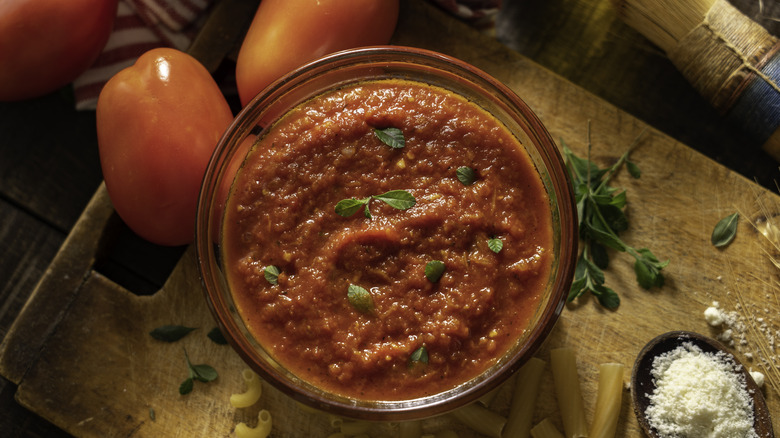The Unexpected Ingredient You Need To Try For Reviving Leftover Pasta
While leftover pasta is a welcome treat, reheating the dish comes with a few challenges. First and foremost, the texture of pasta can become unpleasant the next day, which may ruin your meal. In this case, there's a neat little trick you can try to imbue pasta with the perfect flavor and texture. Simply add a bit of salsa to the pasta, and mix well to keep the dish moist when reheating.
While just about any sauce can help pasta retain its texture, salsa is a particularly attractive option because it will also enhance the flavor. For the best results when reheating pasta, combine a bit of salsa and a portion of pasta in a bowl. Place the pasta in the microwave and cover it with a paper towel to ensure that steam can easily rise out of the bowl. Heat the pasta for about a minute and a half, stir, and heat for another minute.
How do salsa and marinara compare?
The salsa-pasta reheating hack is particularly ingenious because salsa and marinara share quite a few similarities. While salsa recipes can vary in ingredients and flavor profiles, the classic ingredients in tomato-based salsa (also known as salsa roja) include onions, peppers, and tomatoes. Many salsa recipes also include garlic, as does classic tomato sauce.
A frequent accompaniment to pasta, including spaghetti and penne ziti, the star ingredient in marinara is tomatoes. The Italian tomato sauce also includes onions and garlic, as well as seasonings like oregano, basil, black pepper, and salt. Additionally, it's common to include flakes of red pepper to infuse marinara with a minimal amount of heat.
When you break down the ingredients of each sauce, it's plain to see that salsa and marinara are more alike than they are different. However, the key to tasty pasta leftovers is selecting your salsa carefully.
Best practices when combining salsa with leftover pasta
When pairing salsa with pasta dishes, choosing the right variety is key to an enjoyable experience. In this case, use a salsa that goes heavy on the garlic, as garlic is a key ingredient in marinara. A garlic-forward salsa will mesh well with many pasta dishes in terms of flavor while infusing it with much-needed moisture.
Steer clear of extremely spicy salsas, as they're likely to clash with the dish. In this case, mild varieties are best, as they typically contain fewer spicy peppers.
The thickness of the salsa is another factor to consider, as some salsa brands are designed to be chunky to pair with tortilla chips. Use a less-chunky, restaurant-style salsa to ensure the pasta can easily absorb the tomato-based sauce and all of the flavors that accompany it. With these tips, you can breathe new life into leftover pasta.


